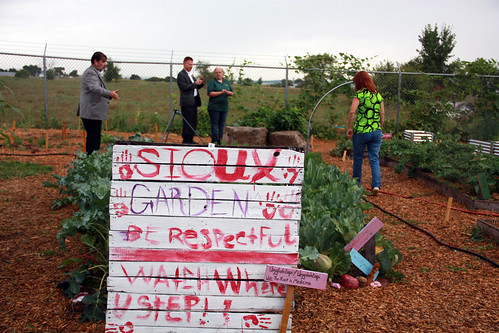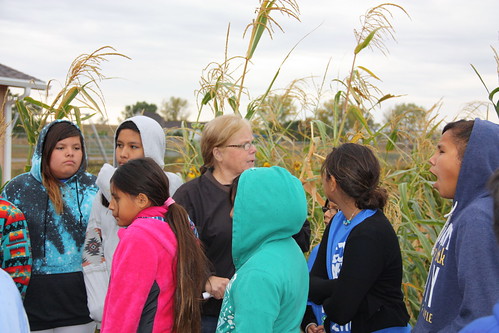
The Cannon Ball Elementary School Garden on the Standing Rock Sioux reservation in North Dakota.
USDA celebrates National Native American Heritage Month in November with a blog series focused on USDA’s support of Tribal Nations and highlighting a number of our efforts throughout Indian Country and Alaska.
What we teach our children about food can shape how they eat, learn, grow and live. While I was on the Standing Rock Sioux Reservation in North Dakota, I saw firsthand how a community garden can bring learning to life.
Planting a garden near their school, elementary students in Cannon Ball created a hands-on, outdoor classroom where they are taught how to grow their own food, a skill that will last a lifetime. The garden not only promotes a healthy lifestyle, it improved the students’ behavior and performance at school and developed their appreciation for the environment.
Last summer, President Obama visited the reservation community of Cannon Ball, one of the most poverty-stricken areas in the state. His focus was on creating opportunities for native youth.
To me, the community garden project is a good example of the kind of community-led opportunity the President talked about. Based on the outcomes we saw while I was there, the garden is also a strong validation of Agriculture Secretary Tom Vilsack’s StrikeForce initiative that focusses on areas around the nation that have historically been underserved. The initiative targets regions of poverty where USDA staff can work with other organizations to increase awareness of programs, target resources and leverage partnerships.
Using USDA Agricultural Marketing Service’s Specialty Crop Block Grant (SCBG), ND State University Extension Service and the Dakota Prairies Resource Conservation and Development Council are expanding on the idea of learning through gardening. Funding from these grants is distributed to state agriculture departments who pass it on to experienced partner organizations such as NDSU. With this grant, NSDU will establish a larger garden within walking distance of the school on bluffs overlooking the Missouri River. A high tunnel greenhouse is also under construction and will sit near a historic root cellar. Built in the 1930s, the cellar will be restored as a modern storage and distribution facility for the garden’s produce.
In the past, Standing Rock used SCBG funds to start gardens in Fort Yates before expanding to Cannon Ball. And, the harvested fruits and vegetables are sold at the local farmers market where elderly residents may take advantage of vouchers from other programs to receive free produce. So, in addition to the many educational benefits for students and teachers, these local garden projects also provide access to nutritious food that helps combat obesity, diabetes and related illnesses across the community and the reservation.
NOTE – Since my visit, a fire destroyed the school garden and three nearby homes. Thankfully there were no fatalities. Cannon Ball Elementary School and the community garden were spared. Far from being discouraged, the students and the community plan to rebuild and expand their efforts to include a new community wellness center.

Some of the elementary school students who made their school garden such a success, along with Sue Isbell, ND State University Extension Agent.
No comments:
Post a Comment
Note: Only a member of this blog may post a comment.